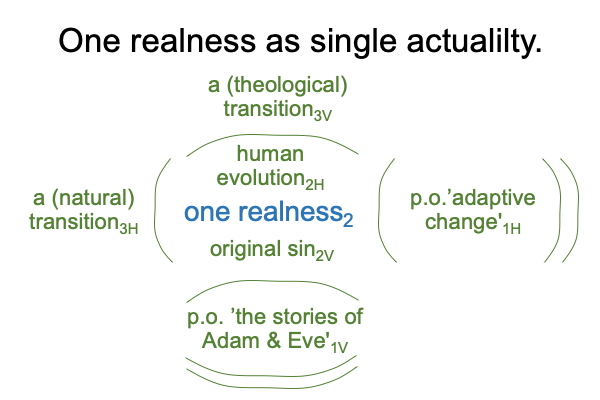0009 The actualities of human evolution2 and original sin2 intersect.
Here is the diagram of the intersection for this example.

0010 The intersection is a relational structure. The e-masterwork, How To Define The Word “Religion”, available at smashwords and other e-book venues, introduces the intersection. This relational structure associates to the message underlying the term, “religion”.
0011 Note how all the items in Haarsma’s title are captured by elements in the above intersection.
Two transitions (3H and 3V) touch base with the question, “When?”.
Two actualities (2H and 2V) go with human evolution2H and the doctrine of original sin2V. These two actualities join into a single reality, which I currently label as one realness.
The potentials (1H and 1V) are implied. Let me examine each.
0012 The potential of adaptive change1H arises in response to a niche. Typically, the niche involves some material advantage (to be exploited) or disadvantage (to be ameliorated). For our lineage, the niche involves immaterial advantages and disadvantages. How so? The Homo lineage adapts into the niche of triadic relations, as discussed in the e-masterwork, The Human Niche.
0013 The potential of the start of sin1V is not so different than the potential of the Genesis Primeval History1V. For this reason, I enter the potential of the stories of Adam and Eve1V, as the possibility underlying original sin2V. I could also have entered the potential of the letters of Saint Paul1V.
At the same time, the mythological character of the Primeval History comes into play. The stories of Genesis 2:4-11 are set in the Ubaid, Uruk and Sumerian Dynastic archaeological periods.This setting is discussed in the February 2022 blog series at www.raziemah.com, entitled, Looking at Carol Hill’s Article (2021) “Original Sin with respect to Science”.
